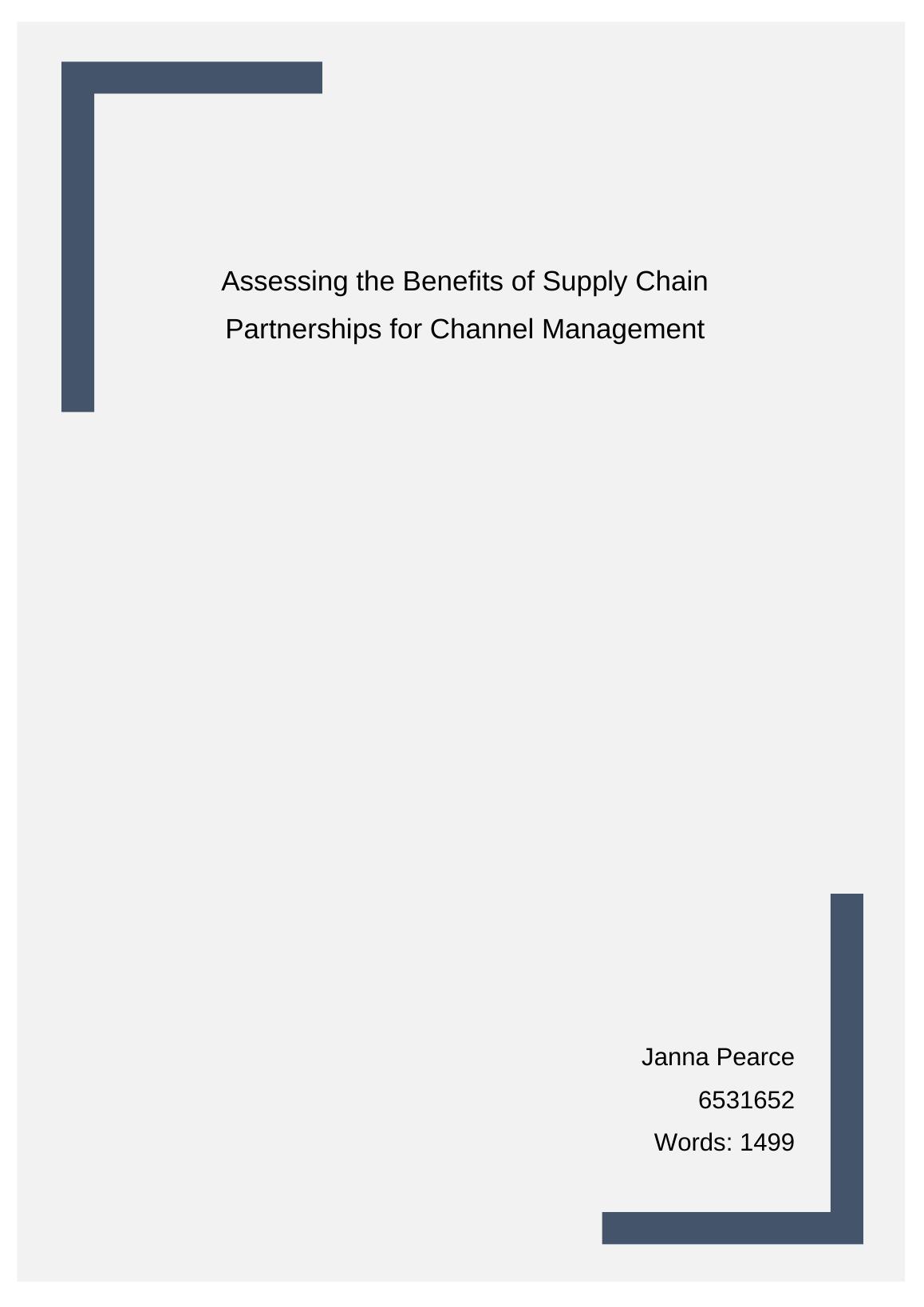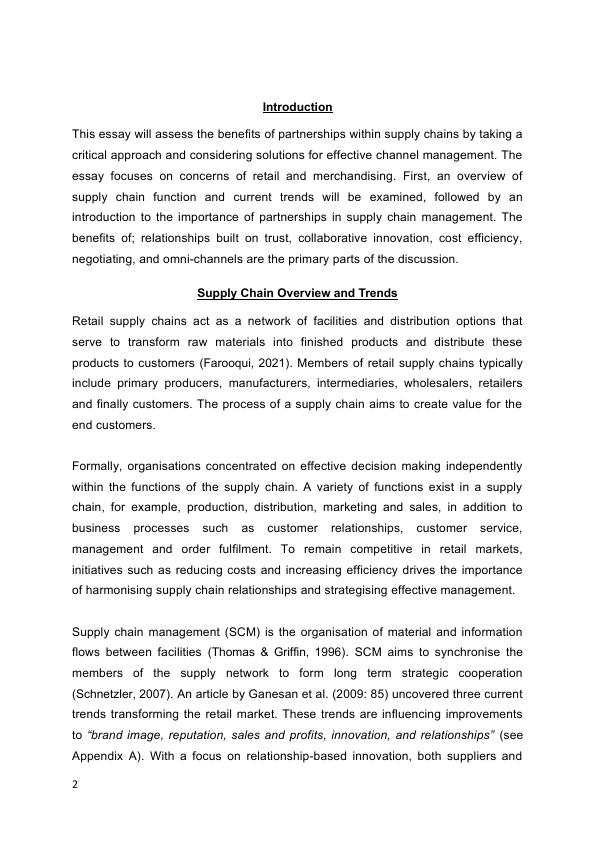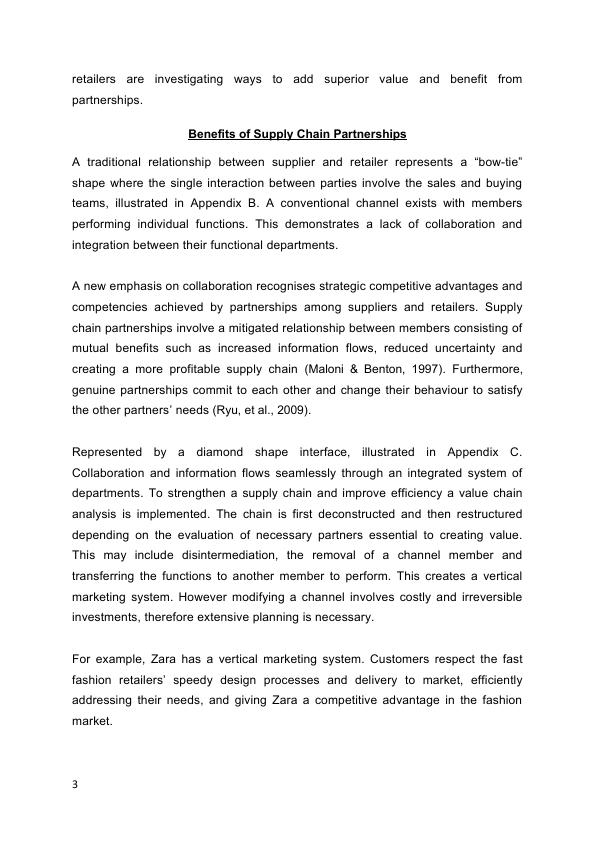Supply Chain Overview and Trends
Added on 2022-02-24
12 Pages2593 Words24 Views
Assessing the Benefits of Supply Chain
Partnerships for Channel Management
Janna Pearce
6531652
Words: 1499
Partnerships for Channel Management
Janna Pearce
6531652
Words: 1499

Table of Contents
Introduction.................................................................................................................2
Supply Chain Overview and Trends.........................................................................2
Benefits of Supply Chain Partnerships...................................................................3
Trust-Based Relationships....................................................................................4
Collaborative innovation........................................................................................5
Cost Benefits...........................................................................................................5
Negotiations to Improve Partnerships..................................................................6
Omni-channels........................................................................................................6
Conclusion..................................................................................................................7
Bibliography................................................................................................................8
Appendix...................................................................................................................10
Appendix A – Supply Chain Trends and Retailer Payoffs.................................10
Appendix B – Traditional Buyer Supplier Interface............................................10
Appendix C – Model of Strong Partnerships.....................................................11
Appendix D – Buyer Firm Mediated Path from Trust Strategy to Firm..............11
1
Introduction.................................................................................................................2
Supply Chain Overview and Trends.........................................................................2
Benefits of Supply Chain Partnerships...................................................................3
Trust-Based Relationships....................................................................................4
Collaborative innovation........................................................................................5
Cost Benefits...........................................................................................................5
Negotiations to Improve Partnerships..................................................................6
Omni-channels........................................................................................................6
Conclusion..................................................................................................................7
Bibliography................................................................................................................8
Appendix...................................................................................................................10
Appendix A – Supply Chain Trends and Retailer Payoffs.................................10
Appendix B – Traditional Buyer Supplier Interface............................................10
Appendix C – Model of Strong Partnerships.....................................................11
Appendix D – Buyer Firm Mediated Path from Trust Strategy to Firm..............11
1

Introduction
This essay will assess the benefits of partnerships within supply chains by taking a
critical approach and considering solutions for effective channel management. The
essay focuses on concerns of retail and merchandising. First, an overview of
supply chain function and current trends will be examined, followed by an
introduction to the importance of partnerships in supply chain management. The
benefits of; relationships built on trust, collaborative innovation, cost efficiency,
negotiating, and omni-channels are the primary parts of the discussion.
Supply Chain Overview and Trends
Retail supply chains act as a network of facilities and distribution options that
serve to transform raw materials into finished products and distribute these
products to customers (Farooqui, 2021). Members of retail supply chains typically
include primary producers, manufacturers, intermediaries, wholesalers, retailers
and finally customers. The process of a supply chain aims to create value for the
end customers.
Formally, organisations concentrated on effective decision making independently
within the functions of the supply chain. A variety of functions exist in a supply
chain, for example, production, distribution, marketing and sales, in addition to
business processes such as customer relationships, customer service,
management and order fulfilment. To remain competitive in retail markets,
initiatives such as reducing costs and increasing efficiency drives the importance
of harmonising supply chain relationships and strategising effective management.
Supply chain management (SCM) is the organisation of material and information
flows between facilities (Thomas & Griffin, 1996). SCM aims to synchronise the
members of the supply network to form long term strategic cooperation
(Schnetzler, 2007). An article by Ganesan et al. (2009: 85) uncovered three current
trends transforming the retail market. These trends are influencing improvements
to “brand image, reputation, sales and profits, innovation, and relationships” (see
Appendix A). With a focus on relationship-based innovation, both suppliers and
2
This essay will assess the benefits of partnerships within supply chains by taking a
critical approach and considering solutions for effective channel management. The
essay focuses on concerns of retail and merchandising. First, an overview of
supply chain function and current trends will be examined, followed by an
introduction to the importance of partnerships in supply chain management. The
benefits of; relationships built on trust, collaborative innovation, cost efficiency,
negotiating, and omni-channels are the primary parts of the discussion.
Supply Chain Overview and Trends
Retail supply chains act as a network of facilities and distribution options that
serve to transform raw materials into finished products and distribute these
products to customers (Farooqui, 2021). Members of retail supply chains typically
include primary producers, manufacturers, intermediaries, wholesalers, retailers
and finally customers. The process of a supply chain aims to create value for the
end customers.
Formally, organisations concentrated on effective decision making independently
within the functions of the supply chain. A variety of functions exist in a supply
chain, for example, production, distribution, marketing and sales, in addition to
business processes such as customer relationships, customer service,
management and order fulfilment. To remain competitive in retail markets,
initiatives such as reducing costs and increasing efficiency drives the importance
of harmonising supply chain relationships and strategising effective management.
Supply chain management (SCM) is the organisation of material and information
flows between facilities (Thomas & Griffin, 1996). SCM aims to synchronise the
members of the supply network to form long term strategic cooperation
(Schnetzler, 2007). An article by Ganesan et al. (2009: 85) uncovered three current
trends transforming the retail market. These trends are influencing improvements
to “brand image, reputation, sales and profits, innovation, and relationships” (see
Appendix A). With a focus on relationship-based innovation, both suppliers and
2

retailers are investigating ways to add superior value and benefit from
partnerships.
Benefits of Supply Chain Partnerships
A traditional relationship between supplier and retailer represents a “bow-tie”
shape where the single interaction between parties involve the sales and buying
teams, illustrated in Appendix B. A conventional channel exists with members
performing individual functions. This demonstrates a lack of collaboration and
integration between their functional departments.
A new emphasis on collaboration recognises strategic competitive advantages and
competencies achieved by partnerships among suppliers and retailers. Supply
chain partnerships involve a mitigated relationship between members consisting of
mutual benefits such as increased information flows, reduced uncertainty and
creating a more profitable supply chain (Maloni & Benton, 1997). Furthermore,
genuine partnerships commit to each other and change their behaviour to satisfy
the other partners’ needs (Ryu, et al., 2009).
Represented by a diamond shape interface, illustrated in Appendix C.
Collaboration and information flows seamlessly through an integrated system of
departments. To strengthen a supply chain and improve efficiency a value chain
analysis is implemented. The chain is first deconstructed and then restructured
depending on the evaluation of necessary partners essential to creating value.
This may include disintermediation, the removal of a channel member and
transferring the functions to another member to perform. This creates a vertical
marketing system. However modifying a channel involves costly and irreversible
investments, therefore extensive planning is necessary.
For example, Zara has a vertical marketing system. Customers respect the fast
fashion retailers’ speedy design processes and delivery to market, efficiently
addressing their needs, and giving Zara a competitive advantage in the fashion
market.
3
partnerships.
Benefits of Supply Chain Partnerships
A traditional relationship between supplier and retailer represents a “bow-tie”
shape where the single interaction between parties involve the sales and buying
teams, illustrated in Appendix B. A conventional channel exists with members
performing individual functions. This demonstrates a lack of collaboration and
integration between their functional departments.
A new emphasis on collaboration recognises strategic competitive advantages and
competencies achieved by partnerships among suppliers and retailers. Supply
chain partnerships involve a mitigated relationship between members consisting of
mutual benefits such as increased information flows, reduced uncertainty and
creating a more profitable supply chain (Maloni & Benton, 1997). Furthermore,
genuine partnerships commit to each other and change their behaviour to satisfy
the other partners’ needs (Ryu, et al., 2009).
Represented by a diamond shape interface, illustrated in Appendix C.
Collaboration and information flows seamlessly through an integrated system of
departments. To strengthen a supply chain and improve efficiency a value chain
analysis is implemented. The chain is first deconstructed and then restructured
depending on the evaluation of necessary partners essential to creating value.
This may include disintermediation, the removal of a channel member and
transferring the functions to another member to perform. This creates a vertical
marketing system. However modifying a channel involves costly and irreversible
investments, therefore extensive planning is necessary.
For example, Zara has a vertical marketing system. Customers respect the fast
fashion retailers’ speedy design processes and delivery to market, efficiently
addressing their needs, and giving Zara a competitive advantage in the fashion
market.
3

End of preview
Want to access all the pages? Upload your documents or become a member.
Related Documents
The Relationships Between Supply Chain and Firm Performancelg...
|4
|1414
|39
Managing Supply Chain Management - Deskliblg...
|16
|644
|472
Logistics and Supply Chain Management Spring: Doclg...
|11
|2959
|444
Supply Chain Evaluation of NH Food Australialg...
|18
|1674
|243
How to Improve Supply Chain Relationships and Mitigate Riskslg...
|12
|2205
|260
Dell IT Supply Chain Strategieslg...
|13
|2197
|21
